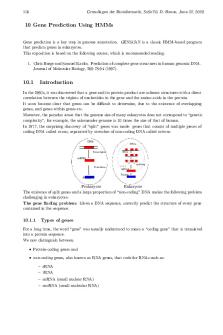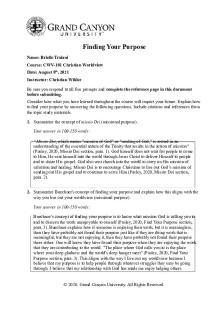Pop-Culture Critique: Finding Dory PDF

| Title | Pop-Culture Critique: Finding Dory |
|---|---|
| Author | Veronica Joseph |
| Course | Behavioural Neuroscience |
| Institution | University of Guelph |
| Pages | 6 |
| File Size | 125.3 KB |
| File Type | |
| Total Downloads | 95 |
| Total Views | 153 |
Summary
Pop culture critique on Finding Dory in context of psychological neuroscience...
Description
1
Do you ever walk into a room with a purpose and then suddenly forget why you came into the room in the first place? The failure to recall recent events or Anterograde Amnesia is a more permanent version of that experience. Aggleton, 2008, describes Anterograde Amnesia as the extreme and perpetual loss of latest events (Aggleton, 2008). This also leads to loss of episodic memory. Although memory has been studied since antiquity, it only started showing up in medical books and encyclopedias in the 19th century (Langer, 2019). When talking about anterograde amnesia, the medial temporal lobe and the medial diencephalon are the most talked about as the most linked to this disorder (Aggleton, 2008). The medial temporal lobe includes the hippocampus, amygdala and parahippocampal regions. The famous Patient HM was helpful in discovering that the acquisition of new memories was specifically a cerebral function that is separate from cognitive and perceptual capabilities (Squire & Zola-Morgan, 1991) but it was still hard to pinpoint which part of the medial temporal lobe was responsible directly for memory in humans. Patient HM ‘s hippocampus and prefrontal cortex had bilateral damage due to surgery to help cure his epilepsy, yet he still performed well on intelligence tests but seemed to have slight impairments in tests on semantic memory (Squire & Zola-Morgan, 1991). The medial diencephalon contains the Thalamus, Hypothalamus and the epithalamus. Impairment to the mamillary nuclei in the diencephalon causes what is known as Korsakoff’s Syndrome, or diencephalic amnesia. But Korsakoff’s Syndrome is usually caused due to excessive alcohol consumption. In a study done by Gold and Squire (2006), three patients that had excessive damage to thalamic nuclei, mammillary nuclei, mammillothalamic tracts, and anterior nuclei of the thalamus, as well as excessive bilateral damage to the hippocampus each. All three of them showed the similar phenotype of amnesia with impairments on declarative memory (Gold & Squire, 2006). Anterograde Amnesia is still quite a mystery to psychologists since research has not yet pinpointed the structure of withholding memories in humans.
1
In 2003, we were introduced to a little regal blue tang named Dory in the Pixar film Finding Nemo who seemed to be quite forgetful but ends up a critical character to help the clownfish Marlin to find his lost son. In 2016, Pixar released a spin-oof to Finding Nemo called Finding Dory which provided an in-depth look into Dory’s character and how she deals with her frequent forgetfulness. The movie starts with the little blue fish getting separated from her parents during her childhood. When she was young, her parents drilled it into her so that she explained her condition to people she meets so that they don’t get confused when she immediately forgets about what they just talked about. She tries to find her way back to them but ends up progressively forgetting about them due to her anterograde amnesia. A year after meeting Marlin and Nemo the clownfish, she lives with them on the reef till she gets a flashback of her parents and tries to look for them again but is unable to due to her condition. She then enlists the help of Marlin and Nemo in search of her parents when Nemo mentions the name of the place her parents are from, Morro Bay, California. After running into trouble, she gets separated from the clownfish and journeys the rest of the way by herself, making new friends and finding old ones. She runs into a 7-tentacled octopus at the Marine Life Institute where he offers his help for her yellow tag that they put on her but she gets confused, wondering what tag he was talking about. He then asks her how she forgot that they put the tag on her and she explains that she suffers from short term memory loss. She eventually finds her way back by seeing certain brain corals and remembering how her parents used those to help her find her way back home. She eventually reunites with all her friends and family and reach back to the reef she was living in with Marlin and Nemo.
1
There are various instances where she displays her anterograde amnesia: she has trouble remembering Nemo’s name, immediately forgetting about a conversation she just had with someone, forgetting navigational directions and why she was going there in the first place. In the beginning, her parents can be seen trying to teach her basic life skills and being aware of her condition and worrying if she would ever survive by herself. We can see that Dory is able to function normally; she remembers habitual things such as knowing how to speak, swim and reading English because her implicit memories are not affected by anterograde amnesia. “I just, I remember things better with you.” Dory says these words to Marlin in Finding Nemo when she tries to get Marlin to stay and look for his son and not leave her. These words express how she was in need of support to help her with her short-term memory loss. Taulbee & Folsom, (1966) suggests reality orientation, where easing amnesiac patients back into a familiar environment by surrounding them with sounds, objects and smells they recognise, helps them get oriented with their current reality and ultimately improve their quality of life. This method has also been found successful on patients with post-traumatic amnesia and traumatic brain injuries (de Guise et al., 2005). Dory seems to remember more with Marlin and is able to concentrate and learn things better with him. Social and family support has also shown to be favourable to patients with amnesia (de Guise et al., 2005b). Nemo and Marlin represent two types of reactions someone with anterograde amnesia would come across. Nemo represents acceptance and growth, always encouraging and supporting Dory while Marlin displays frustration and anger around her, seemingly displeased with her condition, yet he starts to warm up to her and supports her towards then end. When Marlin angrily blames Dory for an attack they encountered on their journey, she swims away and immediately gets captured by the Marine Life Institute. Nemo chides his father, reprimanding him for discouraging her. Dory is usually seen with a positive
1
attitude which helps her memory retention. Her mantra “Just keep swimming!” seems to have helped her survive this far with her condition. Repetition also seems to help her remember but if she loses her concentration, she immediately forgets everything.
Finding Dory seems to portray an accurate representation of anterograde amnesia except for the ambiguity with what caused her to have it. She mentions that it ran in her family “…I think”. Besides drug use and brain injury, individuals acquiring this condition from birth have been rare, though not impossible (Allen, 2018). Usually, a person gets diagnosed with Anterograde Amnesia after a traumatic injury to the head or a disease. They will remember everything up to the point when they were injured ( Patient HM) and forget everything after that point after an extremely short period of time. Dory exhibits all the signs of someone with anterograde amnesia. She remembers everything basic and habitual for her but forgets immediate information that she gets. Her entire journey is sprinkled with people suffering from various disabilities and all of them doing their best to overcome it. Her parents worry about her Dory not being able to survive on her own was deflated as throughout the movie it shows how she manages to get by on her own and surrounded by those who love her and help her. Finding Dory also provides depth to a character who was basically the comic in Finding Nemo and tries to shed light on the difficulties faced by those with amnesia.
1
References Aggleton, J. P. (2008). EPS Mid-Career Award 2006: Understanding anterograde amnesia: Disconnections and hidden lesions. Quarterly Journal of Experimental Psychology, 61(10), 1441–1471. https://doi.org/10.1080/17470210802215335
Langer, K. (2019). Early History of Amnesia. Frontiers of Neurology and Neuroscience, 64–74. https://doi.org/10.1159/000494953
Dewar, M. T., Cowan, N., & Sala, S. D. (2007). Forgetting Due to Retroactive Interference: A Fusion of Müller and Pilzecker’s (1900) Early Insights into Everyday Forgetting and Recent Research on Anterograde Amnesia. Cortex, 43(5), 616–634. https://doi.org/10.1016/s0010-9452(08)70492-1
Squire, L. R., & Zola-Morgan, S. (1991). The Medial Temporal Lobe Memory System. Science, 253(5026), 1380–1386. https://doi.org/10.1126/science.1896849
Gold, J. J., & Squire, L. R. (2006). The anatomy of amnesia: Neurohistological analysis of three new cases. Learning & Memory, 13(6), 699–710. https://doi.org/10.1101/lm.357406 Taulbee, L. R., & Folsom, J. C. (1966). Reality Orientation for Geriatric Patients. Psychiatric Services, 17(5), 133–135. https://doi.org/10.1176/ps.17.5.133
de Guise, E., Leblanc, J., Feyz, M., Thomas, H., & Gosselin, N. (2005). Effect of an integrated reality orientation programme in acute care on post-traumatic amnesia in patients
1
with traumatic brain injury. Brain Injury, 19(4), 263–269. https://doi.org/10.1080/02699050400004971
Allen, R. J. (2018). Classic and recent advances in understanding amnesia. F1000Research, 7, 331. https://doi.org/10.12688/f1000research.13737.1...
Similar Free PDFs

Critique
- 1 Pages

Script-10-Gene Finding
- 8 Pages

Finding peer-reviewed articles
- 4 Pages

Counselling Critique
- 5 Pages

Critique 1
- 1 Pages

Skills Critique
- 1 Pages

Critique - assignment
- 9 Pages

Article Critique
- 5 Pages

Mate Finding- lecture 2
- 2 Pages

Finding Your Purpose Worksheet
- 3 Pages

Article critique
- 2 Pages

Solution Root Finding
- 9 Pages

Critique 15
- 1 Pages
Popular Institutions
- Tinajero National High School - Annex
- Politeknik Caltex Riau
- Yokohama City University
- SGT University
- University of Al-Qadisiyah
- Divine Word College of Vigan
- Techniek College Rotterdam
- Universidade de Santiago
- Universiti Teknologi MARA Cawangan Johor Kampus Pasir Gudang
- Poltekkes Kemenkes Yogyakarta
- Baguio City National High School
- Colegio san marcos
- preparatoria uno
- Centro de Bachillerato Tecnológico Industrial y de Servicios No. 107
- Dalian Maritime University
- Quang Trung Secondary School
- Colegio Tecnológico en Informática
- Corporación Regional de Educación Superior
- Grupo CEDVA
- Dar Al Uloom University
- Centro de Estudios Preuniversitarios de la Universidad Nacional de Ingeniería
- 上智大学
- Aakash International School, Nuna Majara
- San Felipe Neri Catholic School
- Kang Chiao International School - New Taipei City
- Misamis Occidental National High School
- Institución Educativa Escuela Normal Juan Ladrilleros
- Kolehiyo ng Pantukan
- Batanes State College
- Instituto Continental
- Sekolah Menengah Kejuruan Kesehatan Kaltara (Tarakan)
- Colegio de La Inmaculada Concepcion - Cebu


